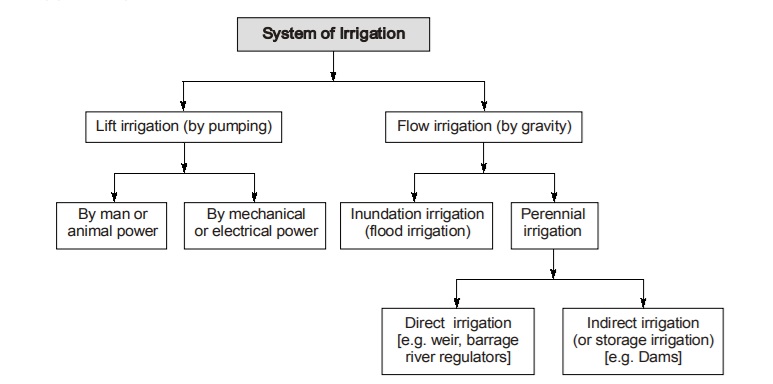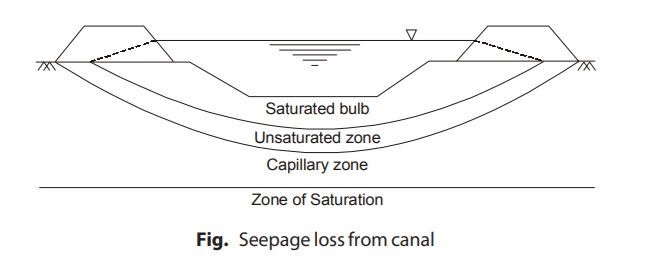Systems of Irrigation: Advantages and Disadvantages
Systems of Irrigation
In irrigation system, there are surface irrigations where you provide water on the surface by gravity force (flow Irrigation); and there is pressurized irrigation system (lift Irrigation), for example, micro irrigation or drip irrigation, where you need to pressurize the irrigation through pumps so that water can penetrate through the small pore of dripper or sprinklers.

Standard of Irrigation Water
There should be some limits to the impurities present in the water so that yield of crop is not hampered. Various types of impurities are present in water.
Sediment Concentration in Water
- Very fine sediment (for g.: fine silt) when deposited on sandy soil increases the fertility of soil.
- Excessive suspended sediment may create trouble in canals and reservoir.
- Sediment derived from eroded areas may reduce the fertility of soil.
Concentration of Soluble Salt
- Salts of Ca2+, Mg2+, Na+ and K+ may be injurious to crops if it exceeds the permissible limit.
- Excessive quantity of salts reduces the osmotic activities of the plants and may prevent adequate aeration causing injuries to plant growth.
- Salinity concentration may be measured electrically or it may be computed by laboratory test.
Advantages of Irrigation
- Increase in crop yield: Increase in crop yield: Increase in crop yield occurs on account of good irrigation systems leading to increase in food production.
- Protection against famines: Food production of a country can be increased by availing irrigation facilities. This helps preventing famine situations.
- Revenue Generation: Assumed supply of irrigation water leads to growing of superior crops by the farmers. Farmers become prosperous by selling the crops while governments revenue is generated by imposing taxes on irrigation water.
- Avoidance of mixed cropping: Mixed cropping means sowing of two or more crops together in the same field when weather conditions are not favorable for a particular type of crop. The need of mixed cropping is eliminated if we have good irrigation facility.
- Navigation: Irrigation canals may be used for inland navigation. Inland navigation is useful for communication and transportation.
- Hydroelectric power generation: Major river valley projects are planned to provide hydroelectric power together with irrigation. Thus, at the same time dual purpose is served.
- Generation of employment opportunities: During construction of irrigation works like canal headworks, weir/barrage, overhead irrigation works, employment opportunities are generated.
Disadvantages of Irrigation
- Wastage of irrigation water: Abundant supply of irrigation water tempts the cultivators to use more than the required amount of water.
- Formation of marshy land: Excessive seepage of water from irrigation canals may lead to formation of marshy lands along the course of the canals.
- Dampness in weather: Temperature of the commanded area of irrigation project gets lowered considerably and the area may become Dampness in the area lead to occurrence of diseases originating from dampness.
- Loss in valuable lands: In various cases, valuable lands get submerged when storage reservoirs are formed on account of construction of weirs, barrages or dams.
Water Logging
- It is a phenomena in which productivity of land gets affected due to rise in water table, thus leading to the flooding of root zone of the plants.
- In this process, the productivity of land is affected by rise in water table.
- Main factors causing water logging are as follows:
- Inadequate surface drainage
- Seepage from canal system
- Over irrigation of fields
- Obstruction of a natural drainage
- Destruction of a natural drainage
- (Inadequate capacity for arterial drainage
Losses in Canal
- Losses in canal comprises of evaporation from water surface and seepage through bed and sides of the drain.
- Loss due to evaporation from a canal system depends on climatic condition of the region
- Loss due to evaporation is not preventable
- However, loss due to evaporation is considered insignificant in most of the cases (it is around 1 to 50%)
- Loss due to seepage depends upon various factors, Few of the factors are:
- Position of sub soil water table
- Extent of absorbing medium
- Design of canal cross section (i.e. depth of water and velocity of water in the canal)
- Conditions of canal system
- Losses in canal are measured by “inflow and outflow method”.
- Discharge measurement is done at the beginning and end of a long reach of canal for several days continuously
(Outlets should be completely closed during observation period.)
- Seepage loss from canal occurs in two ways:
- Absorption
- Percolation
Absorption:
When water table is considerably below the ground level, seeping water is unable to join the water table and wets the subsoil locally forming a saturated bulb. Hence, an unsaturation zone lies between this saturated zone and zone of capillary moisture.

Percolation:
When water table is close to the ground level, the seeping water may establish a direct and continuous flow between canal section and water. The zone between the water table and the canal bed remains completely saturated. As there is a continuous flow, seepage loss will depend upon the head difference between the full supply level of canal and water table.
Major Cropping Season in India
From agricultural point of view, a year can be divided into three principal cropping seasons:
(a) Kharif season:
In India, Kharif season, starts in June and ends in October. The crops grown in this season are harvested from September to October. These crops require a lot of water and are called as Kharif crops or Monsoon crops. Some important Kharif crops are Rice (Paddy), Bajra, Jowar, Maize (Corn), Soyabean, Cotton, etc.
(B) Rabi season:
In India, Rabi season starts in mid November and ends in April. The crops grown in this season are harvested from February to April. These crops need cool climate during period of growth but warm climate during germination of their seed and maturation. These crops requires less water and are called as Rabi crop or winter crops. Some important Rabi crops are Wheat, Barley, Mustard, Bajra, Pulses, etc.
(C) Zaid season:
In India, Zaid season starts in March (crop is sown) and ends in June (crop is harvested). The crops grown in this season requires warm and dry weather for growth and a longer day time for flouring. These crops are called as Zaid crops or summer crops, Some important Zaid crops are Pumpkin, Cucumber, Bitter Gourd, Watermelon, Muskmelon, etc.
Types of Crops Based on the Life Cycle of Plant
Crops can be broadly classified into three types based on the life cycle of the plant:
(a) Annual Crops
These crops complete their life cycle in a single growing season, typically within one year. They grow from seed, produce fruits or seeds, and then die. Examples of annual crops include wheat, maize, rice, and soybeans.
(b) Biennial Crops
These crops complete their life cycle in two growing seasons, usually taking two years to grow from seed to fruition. In the first year, biennial crops produce only vegetative growth, and in the second year, they produce flowers, fruits, and seeds. Examples of biennial crops include carrots, onions, and beets.
(c) Perennial Crops
These crops grow for multiple years without the need for replanting. They produce crops year after year from the same root system, often for several years or even decades. Examples of perennial crops include fruit trees like apple, citrus, and mango, as well as nut trees like almonds and pecans.
Important Terminology
Gross Command Area (GCA)
It is the total area (including roads, villages, farm, etc) which can be irrigated by a canal system when unlimited quantity of water is available. It includes cultivable as well as un-cultivable area. An irrigation canal system lies is doab (i.e. area between two drainages). Thus, boundaries of gross command area of a canal system is fixed by drainage sides of main irrigation canal.
Culturable Command Area (CCA)
It is that portion of Gross Command Area (GCA) that is culturable or cultivable and includes pastures and fallow lands, which can be made cultivable. However, all the cultivable land may not be actually under cultivation.
Therefore, sometimes culturable commanded area is divided into
- Culturable cultivated area
- Culturable uncultivated area (or to be cultivated)
<< Previous | Next >>
Must Read: What is Irrigation Engineering?


